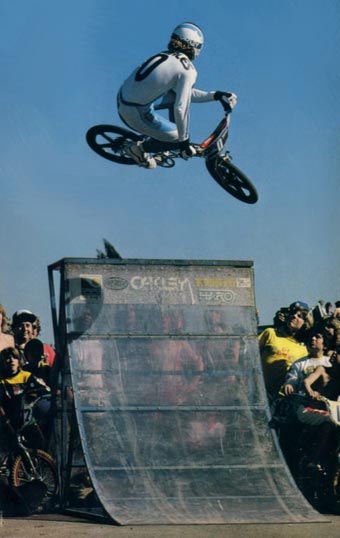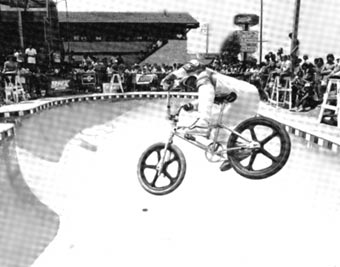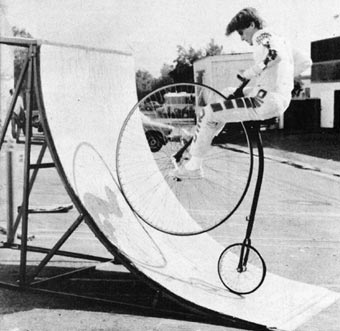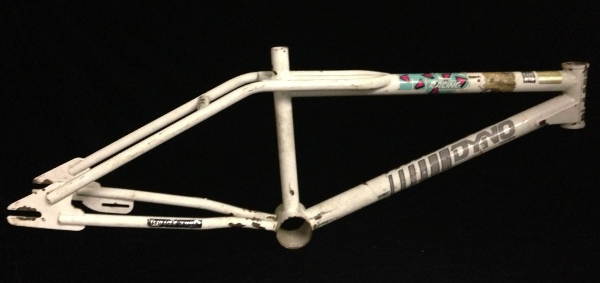I began competing in a new sport of skateboard park "freestyle" contests on my BMX bicycle. I added T-shirts and accessories to my Sticker Factory business and changed the name to Bob Morales Enterprises (BME). I designed my first bicycle frame (on paper) but I had no idea how to go about getting it made or into production, but I knew someday I wanted to design bicycle frames for a living.
I retired from BMX racing and concentrated on BMX freestyle stunt riding. I was hired as the first member of the Haro Freestyle Team and began working with Bob Haro planning a 1981 U.S. tour to promote this new sport and Haro's growing line of products.

That year I also promoted and organized a "Skatepark" bicycle riding contest and formed the Amateur Skate Park Association (ASPA), an organization which promoted BMX freestyle competition.
My BME company was also continuing to grow and added its own brand of accessories that I named "Dyno Design". Dyno's first product line included BMX jerseys, racing pants and T-shirts. BME/DYNO participated in the first Interbike trade show in Las Vegas, Nevada and I became the youngest company owner to exhibit at a bicycle industry trade show.
In June of 1982 I graduated from high school and was then able to work full-time on my business.

BME/Dyno moved out of my garage into a small warehouse in Huntington Beach, California.
Since I was no longer using skate parks for my events, I changed the American Skate Park Association (ASPA) to the American Freestyle Association (AFA) because "Freestyle" was the word most used to describe our new sport. With the new AFA I started a membership association with Eddie Fiola as the first AFA member.
My BME/Dyno business continued to grow and added new products as well as employees (the annual sales grew to about $250,000). My AFA organization hired its first two employees and set up an office in the BME/Dyno warehouse. We also planned its first event series for 1985. I incorporated the AFA and became its first president. The AFA was very appealing to me because it was a service company. Because most of our revenue was from soliciting sponsorship, entry fees and membership dues, it required very little working capital.


Later that year, GT Bicycles made an offer to buy Dyno. I accepted their offer because Dyno was severely undercapitalized and in need of investment. I negotiated a contract with GT to design bicycle frames and components and to consult on a marketing strategy for them. They also agreed to allow me to continue running my AFA organization while I worked there. I designed the first Dyno freestyle bicycle frame/fork as well as many other Dyno/GT freestyle and BMX products. Dyno went on to become a top selling bicycle and accessory company. To this day Dyno brand products produce over 30 million dollars in annual sales for GT.
After selling Dyno to GT, AFA took over Dyno's former warehouse in Huntington Beach, California in order to increase office and equipment storage space. I brought in a partner to help run the day to day duties for the AFA.
AFA completed its first contest series in California. By using well known riders like Eddie Fiola to endorse the AFA, membership quickly reached 1,000 members. AFA published its first competition rule book for BMX Freestyle and opened three new affiliate offices in Texas, Florida, and New York. AFA also began to organize local AFA competitions in these states and plan a U.S. national series for 1986.
DYNO PROTOTYPE.
Bob Morales, www.facebook.com, december 2013: After I sold Dyno to GT Bicycles they asked me to design a new freestyle frame. This is the prototype that the production is based on. Hand built by Gary Turner from GT frame components and tubing this is the very first Dyno frame prototype. It does not feature the bend in the top tube at the seat stay / platform junction that the production models have. After initial testing I felt it was not unique enough and I suggested the bend in the top tube to give clearance to the seat stays platform and to give it an original design feature. After initial testing to confirm strength and handling, this frame went on to be used by me as a test bike for other GT and Dyno products I designed and developed for them. This frame was also later used to develop the first Kore product the Thrashguard (The first bolt on bash guard). Kore Bicycle Components was a company I started after I left GT in 1987.

The AFA completed its first U.S. series, including an event at Madison Square Garden in New York City with over 200 rider entries and 5,000 paying spectators. AFA membership increased to 2,000 members and published its first membership newspaper. AFA opened up many more affiliate offices around the U.S., helping freestyle to become a national youth cycling sport. I continued to provide design and marketing consultation to GT Bicycles as well as to a bicycle components manufacturer named ACS.
I helped my long-time friend Rick Fair secure a position at GT Bicycles. Two years later, Rick moved to Taiwan to oversee GT's Chinese bicycle production full-time.
Still interested in the product side of the bicycle industry, another friend (Todd Huffman) and I made a low bid on an inventory lot being auctioned off at a bankrupt bicycle company. We won the bid and started a small BMX distribution company named Mor Distributing, "Mor" being short for "Morales." Mor became a distributor of many BMX brands including Dyno. We began designing our own BMX products under the brand name Auburn. My partner was president and ran Mor Distributing full-time while I operated the AFA full-time and consulted to Mor Distributing part-time.
AFA produced its first radio and TV commercials to promote its events around the country. AFA membership rose to 3,000 members and the staff expanded to over 30 people nationwide. AFA also opened up affiliates in Europe and sanctioned events in England, France, and Germany. In 1987 the AFA organized and sanctioned over 100 local, regional, and national events throughout the U.S.
Meanwhile, Mor Distributing introduced a new "BMX" racing frame which I had designed and which we named "Auburn". The Auburn featured a removable rear section that allowed for different length rear sections for frame geometry changes. This was the first concept of its kind.
I resigned and turned over the AFA presidency to our National Director. We moved the AFA headquarters to his offices in Ohio.
Later that year, an economic recession affected the sport of BMX Freestyle which resulted in the entire bicycle industry experiencing a drop in sales of juvenile bicycles. Mor Distributing experienced large losses due to the drop of freestyle bicycles and scooter sales. I decided to sell my interest in Mor Distributing to my partner Todd Huffman.
The following year, GT Bicycles bought Mor Distributing in order to acquire the Auburn BMX brand, and hired Todd Huffman as its marketing director. Todd still works at GT Bicycles to this day.
I returned to product design and marketing and formed Group B a design and marketing firm, which specialized in the bicycle industry. I began to take on some small BMX clients. I was also taking on projects for companies designing and marketing "Mountain Bikes" which became very popular a few years later.
I began designing what would become KORE's first product, the "Thrashguard".
In late 1990 I closed down the AFA to concentrate full-time on Group B.
Group B was contracted by a New York based distributing company called Bike Rack to redesign and market a line of mountain bikes called "Iron Horse". The Iron Horse project became extremely successful.
I had a frame design idea that I had been working on back when I was still involved with my former company Mor Distributing. I offered this design which I called the "A Frame" to Bike Rack / Iron Horse.
My unique A Frame design attracted world wide attention and was an immediate success that set Iron Horse bikes apart from all the other new companies entering the market.
My Group B business began manufacturing and marketing the KORE Thrashguard and it became very successful. Chris Moeller and Dave Clymer of(S&M Bikes) helped me develop and market The KORE Thrashguard. Unfortunately, as often happens with a good idea, GT Bicycles copied my Thrashguard and manufactured it in Taiwan at a lower price. GT also began selling their version of my Thrashguard as original equipment on their bicycles. By the end of 1990, sales of the KORE Thrashguard began to slow down.
However, without success I began searching for an investor to help me move the production of the KORE Thrashguard to Taiwan to better compete with GT. GT Bicycles introduced their version of the Thrashguard at a price that was 30% less than mine. Consequently, sales of the Kore Thrashguard plummeted. I had many supporters of my original product but the majority of my customers switched over to the GT version because of lower price and better availability. I closed down the KORE project.
On November 26, 1991 I was awarded my first patent for the KORE Thrashguard, which the patent named a "Sprocket Protector". Unfortunately KORE was no longer in business making this product.
I was offered a position at Bike Rack/Iron Horse as Director of Marketing.
At Iron Horse, we put together a national race promotion program and formed "Team Iron Horse". We hired a team of professional mountain bike racers that competed in the 1991 national race circuit. I also managed all advertising and marketing of the Iron Horse brand. I was in charge of product development and design, which required two trips a year to Taiwan to visit the factories which made the bikes and oversee the production and quality control. My long time friend Rick Fair left GT Bicycles and stayed in Taiwan to form his own trading company, Iron Horse Bicycles became one of his first clients.
At the end of 1992, when I realized that Bike Rack / Iron Horse was not going to fulfill all of their obligations to me. I decided to leave and break out once again on my own business ventures. One of the broken obligations included the unique A Frame design which I had given them. I further discovered they had not filed for a patent on this design, which they had also agreed to do. I again went to my patent attorney and filed for a patent, as the design had already been introduced to the market (on Iron Horse Bicycles) and the deadline for filing a patent was approaching.
I established Morales Bicycle Company and introduced the A Frame design under my own brand. I had orders for over 100 of these frames before the first one was even produced.
By the end of the year I also made a plan to reestablish KORE with two partners that owned a Los Angeles based machine shop that was manufacturing components for other bicycle companies in the industry.
My contributions to KORE included providing the brand name, creating all of KORE's marketing and advertising efforts, but more importantly designing and developing new products.
At this point I was still without personal income, because KORE and MORALES bikes were just getting started so I began looking for a way to make a living while helping my new companies grow. Marketing and Advertising always came easy to me so I formed an advertising agency with some really talented and creative friends I have known from the bicycle industry. The Agency was called Morales, Bryant & Cudby Advertising. Later shortened to "MBC Advertising"
In late 1993, we introduced a new stem I had designed called the "Lite stem". This unique stem design successfully addressed some problems which other stems in the market had not. In early 1994, I filed for a patent for this unique design on behalf of KORE.
KORE and Morales Bicycle Company attended its first trade show sharing a single 10 x10 booth.
KORE and Morales were demanding more of my time and I could not properly manage all three of my growing businesses: the MBC ad agency, KORE and Morales Bicycle Company. It was a very hard decision for me to choose what to do next.
MBC advertising was already very profitable and paying me a salary. KORE and Morales had yet to show profits and could not afford to pay me a salary. Being the risk taker that I am, I opted for leaving the Ad agency to take a shot at getting MORALES and KORE off the ground. I really enjoy product development, design, manufacturing and marketing and felt that was where I belonged. I believed both KORE and Morales were very similar businesses and could be run together simultaneously. Furthermore, continuing my involvement with MBC Advertising would create a conflict of interest in the minds of MBC's bicycle related customers. In late 1993 I sold my interest in MBC Advertising to focus my efforts and attention to KORE and Morales Bicycles.
My former employer (IronHorse Bicycles) was not too happy about me marketing my own version of my A-Frame Design (Even though they never paid me for it and I had filed a patent) Rather than compete in the market place, they chose to fight in the courtroom. I learned the hard way that the best way to win a legal battle is with lots of cash! And Iron Horse Bicycles had a lot more cash than I did. After battling with them I had no choice but to settle out with a deal that would have them pay me for my design and my patent, but it would not allow me to make anymore "A Frames" under the Morales brand.
Determined to create another patented design, I began finishing another original and unique frame concept that I had been working on for over a year. This eventually became the Morales "Convertible" frame. In September 1993, I displayed the Morales Convertible ATB racing frame. It is the world's first rigid frame that can be converted to a full suspension frame. It was a success at two industry trade shows, with over six magazines featuring photos and product information about the new Convertible frame. Mountain Bike magazine named the Convertible in its top five most talked about new bicycle designs. I also went back into the Freestyle BMX market with a new frame design introduced under the Morales brand.
I leased a small warehouse in Fountain Valley, California and moved KORE from El Segundo and Morales Bicycle Company from my garage into our new warehouse location.
KORE was fast becoming a well known brand in mountain biking. Kore & Morales bikes also hired it's first employees that year.
Also in 1994, I negotiated with GT over their unauthorized use of my Thrashguard design. We settled the dispute out of court, and KORE received a very generous and exclusive contract with Riteway Distributing, GT's distribution company, to distribute KORE products for a minimum of five years. The settlement also allowed for many privileges never before given to a vendor, which consequently gave KORE many advantages over its competitors. This new deal with GT allowed KORE the opportunity to sign its first major O.E.M. order and factory team endorsement contract with GT Bicycles.
KORE attended the Interbike trade show for its second year with its own 10x10 booth.
KORE became incorporated as "Kore Bicycle Components, Inc."
KORE products were being used by more and more of the mountain bike industry's top professionals. Julie Furtado and Nicolas Vouilloz won the Senior & Junior Downhill World Championships equipped with KORE components.
Morales introduced its first BMX frame designed specifically for BMX freestyle "Flatland" riding. No other bicycle company had ever designed a frame for such a specific use. The frame was an instant success.
The frame received a great review and our first sponsored pro rider Jesse Puente was featured on the cover of Ride BMX magazine in June of 1994 riding this frame.
On January 10, 1995, I was awarded my third patent for a new KORE Stem Design.
KORE conducted its first solo national tour on the NORBA race circuit with a booth and technical support for racers. KORE pro ATB racers Julie Furtado, Brian Lopes, and Leigh Donavan won five national championships equipped with KORE components. Nicolas Vouilloz of France also won the Men's Senior Downhill World Championships with KORE components.
Morales Bicycle Company sought an investor to help launch the Convertible frame, but unfortunately the capital was only enough to help the BMX frame project. The Convertible project was canceled until proper financing could be obtained.
Morales BMX frames continued to sell successfully and Morales Bikes built one of the best freestyle teams, winning many major events and press coverage in all of the leading BMX magazines. Morales "Flatland" frames became the most popular frame for this style of riding. Morales Bicycle Company sold over 1,000 of these frames in 1995.
KORE introduced its most advanced and expensive stem, the "Elite Stem". The Elite Stem would be made exclusively in the USA and become our flagship product. We immediately filed a patent for this original design.
KORE attended its first international show at the Taipei convention in Taiwan. The show was very successful and KORE gained many new international and O.E.M. customers. Team GT mountain bike racer Nicolas Vouilloz again won his third consecutive Down Hill World Championship equipped with KORE components.
KORE also sponsored Team Cannondale in 1996 with Alison Sydor winning the Women's World Cross Country Championships as well as the Olympic Silver at the Inaugural Mountain Bike Olympic event at the 1996 Olympic Games.
KORE Stems are rated #1 by Mountain Bike Action, Mountain Bike and VTT (France) magazines. These magazines' reader surveys also rated KORE stems as the #1 choice for their readers next stem purchases.
KORE also introduced more new products in 1996 than ever before, extending our range to over 12 products. Kore finished up the year at just under $2 million in sales.
Morales BMX frame sales were going well and plans were set to introduce a new dirt jumping frame called the Morales "BTS" Morales Bicycle Company began seeking additional capital to provide for company growth.
KORE-sponsored racers also went on to take the Men's Dual Slalom, Women's Dual Slalom, and the Women's Downhill titles. KORE components were used on more ATB champions' bikes than on any other brand in the world!
On July 22, 1997, KORE was awarded its fourth patent for the KORE Elite Stem. This is also my fourth personal patent, for a total of five patents awarded to KORE & Morales.
I was also designing BMX components for Kore to complement my Morales frames.
Morales Bikes Flatland frame was one of the most popular flatland frames on the market and Morales had a really great team including, Edgar Placentia, Jesse Puente, Chase Gouin and World Champion Phil Dolan.
To keep my relationship with my partners at Kore good, I concentrated most my efforts on Kore. This was not good for Morales bikes and things started to slow down for Morales Bikes and new projects were stalled including the New Morales "BTS" frame.
My relationship with my partners at Kore was becoming very stressful. We had many different ideas for the company and realized that we could no longer work well together. After a failed attempt to buy them out, I ended up selling my interest in Kore to them, and moving Morales bikes back to a smaller warehouse in Fountain Valley.
From 1998-2000 I was also running Motocross races at the legendary Carlsbad Raceway on the weekends. I still had a few hundred Morales BTS frames hanging in the warehouse. A friend of mine that sells computers saw all my Morales BTS frames I still had in my warehouse and asked me what I was planning on doing with them. He suggested I list them on E-Bay. I liked the idea, because I could sell them directly to riders at a low price. I began selling Morales BTS frames on E-bay during my spare time.
In my spare time I continued selling off my remaining Morales BTS frames on E-Bay and received many encouraging e-mails from riders that really liked the BTS and were asking about the future of Morales Bikes.
I made a lot of new friends on E-bay and after I sold all my remaining frames (I kept a few for warranty replacement) I still received tons of E-mails from riders all over the world wanting to buy Morales frames. As a matter of fact this website was designed and built by Rick Thomas, a really cool web designer and Old School BMX collector I met through one of my BTS frame auctions on E-Bay.